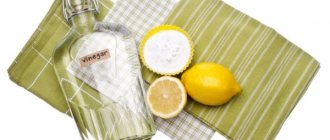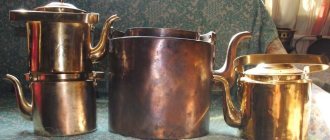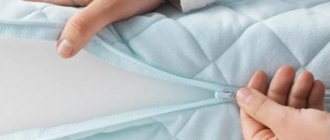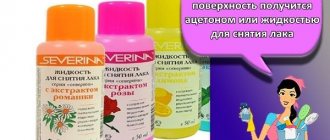How to clean copper oxide at home
Ketchup Dishwashing detergent Lemon juice “Vinegar dough” Bath of vinegar and salt Water and citric acid Paste based on chalk and ammonia Sulfamic acid A solution of oxalic acid, turpentine, citric acid and ethyl alcohol
How to clean copper coins yourself
9% vinegar 10% citric acid Ammonia or ammonium carbonate solution Ammonia
Copper products began to be produced back in the 4th-3rd millennium BC. The golden-pink colored metal was easier to mine than gold, silver and iron. At the same time, copper was then equal in value to precious metals. Copper received its Latin name - cuprum - in honor of the island of Cyprus. It was there that the richest copper deposits were located.
Source: Unsplash (@thecupandtheroad)
Before the development of technology, this metal was used only in the production of jewelry and added to other alloys, after which they began to make dishes and interior items from copper, because, unlike their iron counterparts, vases, plates, teapots and anything else made of copper are resistant to corrosion. Plus, copper also has disinfecting properties. For example, in Ayurveda (Indian traditional medicine), copper has been used since ancient times to sterilize water.
In general, copper products have many advantages, but in order for them to be useful and delight you with their pinkish glow, you need to clean them properly. Otherwise, oxidized copper utensils may become harmful to health.
Why you need to clean regularly
The need for constant cleaning of copper objects arises due to the fact that a dark coating and oxide film quickly appears on the surface. Products that are heated or used in open air conditions oxidize especially quickly. Frequent use of products made of metal causes tarnishing and blackening. The external condition of jewelry made from this metal depends on external factors with which it interacts regularly.
Changes in ambient temperature, humidity and atmospheric pressure lead to the loss of the original decorative appearance.
Copper utensils, if not cleaned, begin to release harmful toxic elements. In this case, you cannot use kitchen utensils for cooking. If you cannot wash the dishes using all available methods, it is better not to use them for their intended purpose in order to avoid negative consequences.
What is copper?
Copper is a ductile, but at the same time durable metal of a reddish-brown color. It is one of the main elements of the periodic table. The copper-based alloy is used to make other metals such as bronze and brass.
The scope of application of this metal is extremely wide. Due to its strength, it is in great demand in construction for the manufacture of wires, fittings, copper mesh, wires and other things. In the agricultural industry, copper is used as part of copper sulfate. Most wind musical instruments are made from copper. This metal is also widely used in the creation of plumbing pipes.
Despite the fact that copper is not a precious metal, it is also in demand in jewelry. You can find a lot of beautiful and very elegant copper jewelry: bracelets, crosses, chains, earrings, rings, etc. Also, to make gold jewelry more durable, an admixture of copper is used.
Copper cezves (Turks) have long become a popular accessory for lovers of delicious coffee.
Products made from this metal can often be found in the kitchen. Due to its resistance to corrosion and good heat conductivity, copper is used to make a huge variety of kitchen utensils: , etc.
It would also not be superfluous to add that in the old days, along with gold and silver, copper was used to make coins, which the common people called copper coins . Many coins have survived to this day.
Copper coin from the times of Tsarist Russia
Unfortunately, in the absence of proper and timely care, copper objects can lose their original shine, become dirty and become cloudy. Let's talk about the main rules that must be followed when caring for copper products.
Reasons for the raid
The occurrence of plaque on a metal coating is associated with external factors. Exposure to metal from the outside changes its condition and reduces its protective characteristics.
Oxidation
When exposed to air, copper products begin to darken and become covered with green stains. Defects are the result of metal oxidation.
Skin exposure
Copper jewelry changes its original shade due to constant close contact with the skin. The secreted sweat contains elements that cause the oxidation process. This process occurs especially strongly in people who have problems with the gastrointestinal tract.
High humidity
Direct contact with water and other liquids, as well as high atmospheric humidity, provoke the formation of plaque. In some cases, items are deliberately patinated to create a decorative effect, while in other situations it is the result of unfavorable environmental conditions.
Metal oxidation
Copper (lat. Cuprum) is a chemical element , which in D.I. Mendeleev’s periodic table is designated by the symbol “Cu” and has serial number 29. It is a transition metal with a characteristic luster of a reddish hue. In most chemical compounds, copper exhibits the +2 oxidation state, but can sometimes be in the +1 oxidation state.
When exposed to open air, the color of the metal changes to red-violet, which is associated with the formation of Cu2O oxide (copper oxide I) on its surface, which then turns into CuO oxide (copper oxide II), which has a blackish tint. In turn, copper ions Cu2+ give it a bluish tint.
Copper objects placed for a long time in a humid atmosphere are covered with a dense hydroxyl film, which has a green color . Copper hydroxide is poisonous. Also, greenish-blue films of copper acetate can form on the surface, which are obtained as a result of the interaction of the metal with acetic acid, have a bitter taste and are poisonous. When using copper cookware for cooking, appropriate precautions must be taken to avoid poisoning due to the presence of oxides and hydroxides on the surface of the copper.
Cleaning products
There are a large number of products for removing oxides from copper objects. In most situations, improvised means are suitable for cleaning.
Table vinegar
Vinegar is used to remove heavy stains that have long formed on the surface. The cleaning process is as follows:
- Vinegar essence is poured into a large stainless steel bowl and table salt is added.
- The container is placed on the fire and the product is placed inside.
- Bring the mixture to a boil, turn off the heat and keep the container on the stove until completely cooled.
- The item is removed from the container, thoroughly washed under running water and wiped dry.
See also
TOP 4 methods of how and with what you can clean a coat at home
Liquid soap
If there is slight tarnishing, you can treat the surface with liquid soap. To do this, the soap is squeezed onto the surface and rubbed forcefully into the contaminated areas. After finishing polishing, wash off the remaining soap with clean water.
Citrus
For convenience, you can cut off half of a citrus fruit and rub it on the coating. Having eliminated visible oxides and dirt, all that remains is to rinse the product with water.
Wine vinegar and flour
A common remedy is vinegar dough, for the preparation of which wine vinegar and flour are mixed in equal proportions. The ingredients are thoroughly mixed until a thick consistency is formed. The resulting mixture is applied to the surface of a metal object and left until a crust forms. Then the dried dough is cleaned off and the coating is polished with a soft cloth.
Ketchup
Small-sized products can be easily cleaned using simple tomato ketchup. You need to squeeze the ketchup into a deep container and immerse the copper object inside. After waiting about 10 minutes, you can remove and wash the product.
Amidosulfuric acid
A solution of amidosulfuric acid effectively removes blackness and other types of contaminants from copper items. To perform cleaning, moisten a rag in an acid solution and rub the surface until the desired result is achieved.
Lemon juice
At home, you can use freshly squeezed lemon juice for cleaning. Soak a rag in the juice and wipe the product.
Soap solution
Unnoticeable tarnishes can be easily removed with a soap solution. Any soap, except laundry soap (due to its alkaline composition), is diluted in heated water, and then the oxidized areas are rubbed with the solution.
Dishwashing gel
Standard dishwashing detergents are suitable for removing fresh oxides. The gel-like product is squeezed onto a soft sponge, rubbed into the surface, and then washed with warm water.
Vegetable oil
Treating copper items with pure vegetable oil effectively removes the deposits that have formed. After treatment, any remaining oil can be washed off with clean water and soap.
How and what to clean copper oxide from at home: the most effective methods
How to clean copper? The relevance of this issue is explained by the fact that products made from this metal have been used by humanity for many centuries. For a long time, the value of this metal was so high that it was equal to gold.
The development of technology has led to the fact that it was possible to significantly reduce the cost of copper production. This made it possible to make not only jewelry from this metal, but also dishes and interior items.
The high popularity of this metal and alloys based on it is explained not only by its decorative effect, but also by its unique characteristics - high ductility, thermal conductivity, corrosion resistance, etc.
Why copper products need to be cleaned regularly
Regular cleaning of copper utensils and other items made from this metal is necessary because during use they quickly darken or become covered with a green coating - an oxide film.
Those products made of copper and its alloys that are often heated during operation or used outdoors are the most actively oxidized.
Dishes made of copper, with active use, quickly lose their original shine and become dull; their surface may become black.
Copper jewelry behaves somewhat differently: it may first fade and lose its shine, and then return to its original appearance. Some people believe that the appearance of copper jewelry (for example, a bracelet) is influenced by the well-being of the person who constantly wears it.
However, this is most likely due to the fact that in the external environment with which such a product is constantly in contact, humidity, pressure and temperature are constantly changing.
Meanwhile, many adherents of alternative medicine recommend wearing copper bracelets for people experiencing problems with the cardiovascular system.
A rare samovar preserved from our great-grandfathers evokes something homely and dear
Copper utensils, which our distant ancestors began to use, are still held in high esteem by many housewives today.
This popularity is explained by the fact that in copper cookware, which is characterized by high thermal conductivity, all cooked products are heated evenly and in full, and such heating occurs in a short period of time.
Meanwhile, with constant use, dishes made of this metal quickly lose their visual appeal: they become covered with a coating of oxide, become dull, darken and lose their original shine. If you do not clean it, it will release toxic substances, and therefore cannot be used for cooking.
If it is not possible to clean such dishes using all known means, it is better not to use them for their intended purpose, so as not to harm your health.
You should also keep in mind that dishes with black or green oxide spots on the surface look unpresentable, so they will not decorate your kitchen.
Effective cleaning methods
There are many proven methods that allow you to clean copper products even at home. Let's get acquainted with the most effective of them.
Method No. 1
One of the most accessible home remedies for cleaning objects made of copper is regular tomato ketchup.
In order to clean copper with this product, it is simply applied to the surface to be treated and left on it for 1-2 minutes. After this exposure, the ketchup is washed off with a stream of warm water.
As a result of this procedure, the copper product will return to its original shine and brightness of color.
Method No. 2
You can clean copper items, if they are not very dirty, at home using regular dishwashing gel. To do this, use a soft sponge on which detergent is applied. Wash it off under running warm water.
Method No. 3
This cleaning method is used if it is necessary to clean a large copper product that cannot be placed in any container. The surface of such an object is wiped with half a lemon. To enhance the effect of lemon juice on copper, you can clean it with a brush with bristles that have sufficient elasticity.
Method No. 4
A product called “vinegar paste” helps give copper its former shine. It is prepared as follows.
How to restore shine
Having wiped off plaque and dirt from a copper product, you need to restore the original shine to maintain decorative properties. There are several polishing options that can be easily performed at home.
Crumpled newspaper
The easiest and most effective way to restore its original shine is to polish it with regular newspaper. You need to roll up a couple of sheets of newspaper into a ball and wipe the tarnished areas with it.
Constantly using this method, you can quickly restore the condition of the products.
Vinegar dough
A dough mixed from vinegar essence and wheat flour is suitable not only for combating stains, but also for polishing. The only difference is that to polish the dough you need to add a pinch of table salt. A mixture of these components is applied to the surface of the object and left until dry. To avoid damaging the coating, it is important to ensure that the salt particles are dissolved before application.
Hydrochloric acid solution
It is recommended to use hydrochloric acid in the most extreme situations. A powerful solution that restores shine after rubbing the surface. For safety reasons, when working with the substance, you need to wear protective gloves and a mask, and open the windows in the room for ventilation.
See also
TOP 10 means and methods on how to clean amber at home
Kerosene and chalk
A mixture of kerosene and chalk chips is applied to a soft sponge and the metal coating is wiped until a characteristic shine is formed. This processing method is suitable for cleaning and finishing products.
Using toothpaste or powder
Abrasives, including toothpaste and powder, contain ingredients that remove tarnish from metal surfaces. The composition is applied to the darkened areas and rubbed in with light force with a soft sponge. Then all that remains is to rinse the residue with heated water and wipe the coating dry.
Features of cleaning various copper products
The processing of various products made of copper alloy must be carried out taking into account a number of features. Following simple rules and choosing the right products will help restore the decorative properties of products.
Coins
If a noticeable coating begins to form on copper coins due to liquid ingress or long-term storage, it can be removed in several ways.
To perform the procedure effectively, you need to prepare a tool and a suitable cleaning agent.
Tool
As a device for cleaning coins, it is enough to prepare a shallow container, a soft cloth and a sponge. If you need to mix the ingredients while preparing the cleaning product, you can use a spoon for convenience.
Professional products
The greatest effect is achieved by using specially developed products for combating stains and polishing metal coatings. Professional products contain components that remove plaque, regardless of how long ago it appeared.
Sodium hydroxide
Sodium hydroxide is a strong alkali that eats away plaque and restores the product to its original condition. When using sodium hydroxide, you must follow safety precautions and wear protective gloves, since if it comes into contact with the skin, it will cause a burn. To restore shine, apply the product to a sponge and wipe the copper coins.
"Reference"
Cleaning agent “Etalon” is a ready-to-use solution of a special complex of reagents for cleaning copper. You can restore the previous shine using “Etalon” by dipping. To process the product, place it in the solution for 5-10 seconds, then rinse with heated water and wipe dry.
"Trilon-B"
Trilon-B effectively removes plaque from copper and copper-containing alloys. To prepare a cleaning solution with a concentration of 10%, mix 100 g of Trilon-B and 1 liter of warm water. Depending on the degree of oxidation of the coins, they are soaked in the prepared solution for from a couple of minutes to several hours. Periodically, the products should be removed from the solution and sprayed with water to check the condition.
"Nanotrilane"
Nanotrilan is produced in the form of a paste and is designed specifically for cleaning metal objects. Instructions for use are as follows:
- a small amount of paste is stirred until smooth, diluting with water if necessary;
- the substance is applied to coins and smeared with a brush or rag;
- After waiting a couple of minutes, the paste is washed off and the products are wiped.
Folk remedies
In addition to specialized means, folk methods help remove plaque from coins. The use of these techniques allows you to perform the procedure at home.
Soap solution
Using a soap solution to clean metal products is the most affordable way. To prepare a solution, stir liquid soap or bar shavings in water.
It is important not to use laundry soap, since due to its alkaline components it can lead to a deterioration in the appearance of the items being treated.
Lemon acid
Exposing copper coins to citric acid helps absorb plaque and combat tarnish. The acid is mixed with vinegar essence, a sponge is soaked in the solution and the coins are rubbed. As an alternative to citric acid, you can use fresh lemon. A slice is cut from a citrus fruit and coins are processed with it. To improve the processing result, you can sprinkle a pinch of table salt on the lemon.
See also
30 best products for cleaning mirrors at home without streaks
Ammonia
The chemical effect of ammonia on copper oxides contributes to their effective elimination. For this purpose, an ammonia solution with a concentration of 5-15% is used. You can freely purchase the substance at a pharmacy. The processing process is no different from using a soap solution and citric acid. Since ammonia has a strong odor, you should wear a respirator when working.
Turk
Coffee Turks are made from a copper alloy, which is often subject to oxidation and tarnishing. There are several techniques that, in practice, are most suitable for cleaning Turks. All options require the use of exclusively available means.
Vinegar and salt
A mixture of essence and salt is applied to the turk, rubbed in and washed off with water. An important condition is that the salt is dissolved in the liquid, since undissolved granules can leave scratches on the coating.
Milk serum
By diluting a couple of tablespoons of salt in a glass of whey, you get a solution for removing oxides from a copper pot. Moisten a soft cloth or sponge in the liquid and rub the product on all sides. After finishing the treatment, wash off the remaining serum under the pressure of water and wipe dry.
Lemon acid
The use of citric acid is suitable for removing oxides, stains and restoring shine. To restore the shine of your coffee grinder, you need:
- dissolve 4 tablespoons of acid in 2 glasses of warm water;
- pour the liquid mixture into a deep container and immerse the Turk inside;
- wait 10 minutes for the dirt to soften;
- wipe the surface with a brush or cloth.
Brine
To clean a copper Turk with brine, apply it to the product and leave for 3-4 minutes. The effect is achieved when using any brine, for example, from cucumbers or sauerkraut. After polishing, traces of brine are washed off and the Turk is wiped with a soft cloth.
Dry cleaning
The dry cleaning method involves the use of soft abrasives and is used in cases of heavy contamination. Chalk chips or coarse flour are used as abrasives. Dry abrasive is applied to a flannel cloth and polished in a circular motion.
Useful tips and tricks
It is worth adhering to the following recommendations to maintain the shine of copper products for a long time:
- To preserve the natural copper shine of objects for a long time, you can use a protective varnish coating. For example, cheap copper jewelry can be coated with clear nail polish. This method allows you to isolate the product from contact with the air atmosphere and human skin, which will preserve its shine for a long time. Besides nail polish, you can also use beeswax. This product can be found in relevant stores.
- Do not use abrasives or steel objects when cleaning copper metal as they are harder than soft copper and can severely scratch the product.
- Heat and humidity are the enemies of copper cookware, as they significantly accelerate their destruction and blackening. To avoid continued exposure to these factors, store the product under appropriate conditions, such as a dry, ventilated cabinet.
- It is not recommended to cook food containing a lot of acids in copper cookware at high temperatures. Products containing acids, such as vinegar, fruits, tomatoes and others, cause serious harm to copper products.
- Most decorative items are coated with a protective varnish layer. Such items should be washed only with warm water and soap and do not use abrasive materials or polish these items, as all this can damage the protective coating. In addition, products with a protective coating require special care, so it is recommended to follow the manufacturer's instructions.
- Some copper food utensils have a protective coating that must be removed before using the utensils for their intended purpose. There are two ways to remove the coating: place the product in boiling water with a small amount of baking soda, or thoroughly wipe the product with a cotton cloth soaked in alcohol or acetone, and then rinse under running water.
- Do not forget to wipe copper products with a damp, clean cloth, not allowing dust and dirt to accumulate on them.
Home methods for cleaning black on copper products should be used from time to time as needed, but you need to understand that the items will become thinner each time.











